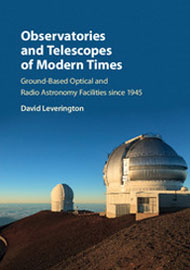
I recommend this book as an incredibly detailed historical record of the design, construction and operation of the world’s ground-based optical and radio astronomy facilities; their spatial and temporal distribution covers all continents from 1945 to the present. We are introduced as well to the advances in optics and electronics during that period: Robert Wood’s telescope with a primary mirror of rotating liquid mercury, adaptive optics to compensate for atmospheric turbulence, charge-coupled devices as imagers, heterodyne interferometers and aperture synthesis.
Author David Leverington also explains the complexities of funding, site selection, design, structural analysis, construction and logistics. These huge projects often required international cooperation and skillful management for their operational success.
The author presents a balanced history and reports on the views and beliefs of disparate groups of stakeholders: for example, we read of the native Hawaiians who view the Mauna Kea Observatory site as a sacred mountain, and we come to understand the difficulty of resolving this conflict. With continued, rapid urban development that often encroaches on observatory sites the light pollution problem worsens. Nevertheless, this book is a testament to the wonders of the universe as detected by optical and radio telescopes.
Review by Barry R. Masters, Fellow of AAAS, OSA and SPIE.
The opinions expressed in the book review section are those of the reviewer and do not necessarily reflect those of OPN or OSA.
